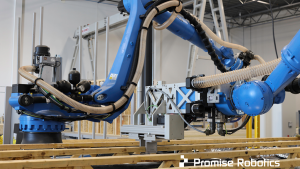Late last year at the International UAV Show in Toronto, Adam Sax unveiled the DX-3, a sleek new drone he claimed would “fundamentally change the drone industry.”
The unmanned aerial vehicle can fly for over 24 hours at a time with a range topping 1500 kilometres.
Sax, the CEO of Toronto-based Sky Guys, which owns the DX-3’s producer Defiant Labs, says, "the real juice" is in its machine learning. Inside the drone’s casing, IBM’s Watson runs on a NVIDIA chipset to equip it with artificial intelligence so that it can collect data as it flies, analyze it, learn from it and relay insights back to its centre of operations.
The last five years have seen an explosion of headlines featuring the terms artificial intelligence (AI), machine learning and deep learning alongside their applications in different industries. A few of these have related to the construction industry. The Sky Guys, for instance, provide their UAVs to construction firms to take aerial videos and photographs, monitor construction progress or identify surface problems not clear from the ground.
Though cases in construction are not numerous yet, AI technology is currently playing a role in construction planning, safety enhancement and building information management.
But what exactly is AI?
"Currently, when people say AI, often what they’re talking about is deep learning," says Jordan Jacobs, CEO of Toronto-based AI software company Layer 6 AI.
AI is an umbrella term that covers a group of techniques that enable machines to "think" like humans. One of AI’s branches is machine learning, of which deep learning is a sub-branch.
Machine learning involves computational models, called artificial neural networks, that learn to reproduce a human behaviour by analyzing massive amounts of data, recognizing patterns, gaining experience and improving.
Computers are not programmed to achieve certain tasks like, say, identifying a truck from a group of random objects. Instead, they employ an algorithm that learns how to identify one.
At specific tasks, machine learning is giving us humans a run for our money. For example, Sony Computer Science Laboratories’ DeepBach learned to create music that is virtually indistinguishable from Bach, at least to the layperson’s ear.
Machine learning’s sub-branch, deep learning, is a technique that involves an algorithm that trains itself to perform complex tasks and recognize increasingly abstract patterns and concepts by using multilayered artificial neural networks — or deep neural networks — to pass output from one neural network through successive layers. The speech translation on your phone, automatic tagging of people in your photos and underpinning of self-driving cars are based on deep learning.
It’s not just mobile software developers and car manufacturers in the deep learning game. Heavyweights in the construction industry have also begun taking interest. Take Komatsu for instance, which two years ago rolled out Smart Construction, its autonomous equipment service assisted by a fleet of drones that survey job sites, create models of current conditions and guide unmanned heavy machinery below.
It’s clear machine learning and deep learning will continue their march into the construction industry. To imagine how, just look at one way it has been employed elsewhere. Over budget and behind schedule — this is a familiar refrain when it comes to large infrastructure projects. In some industries, AI has contributed to a solution.
Take oil and gas for instance.
From his office in Perth, Australia CEO Peter Coleman can look down on the Swan River as he meditates on how Woodside Petroleum, Australia’s largest publicly-traded oil and gas company, can solve the problem of being "rich in history, rich in data, but…poor in analysis."
In oil and gas, value is derived as much from a company’s competency at drilling in deep water as from its ability to capture the knowledge gained on one project and roll it into the next. Impeding that at Woodside was a simple problem: retirement.
In an industry in which 64 per cent of megaprojects experience cost-overruns and 73 per cent experience scheduling delays according to one EY report, access to those decades of knowledge is incredibly valuable. Part of the inspiration for Coleman bringing AI into Woodside came from the $15 billion Pluto Liquified Natural Gas project Woodside had completed. Two years later, Coleman challenged his team to come up with five lessons on the spot.
"We could not consistently give five in our executive team," Coleman told the audience at the IBM World of Watson Conference last year. "If we can’t give five, how in the heck do we think the rest of the organization’s going to do it?"
AI, specifically IBM’s Watson, promised a solution for retaining and efficiently distributing those hard-earned lessons when they are required.
Woodside introduced a Watson-powered program called Lessons Learned, a repository of knowledge that was trained with all the insights gained over the years. An engineer can ask the AI sage a project-related question in plain language and get a natural language response after Watson uses its conversation, language classifier, and retrieve and rank programs to choose and deliver the most suitable answer.











Recent Comments
comments for this post are closed